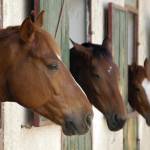Air Quality for Stabled Horses

Mold and dust particles that are inhaled by horses can cause inflammation that puts the lung tissues at risk for increased mucus production, allergic reactions, and infection. Management steps can be used to provide cleaner air for horses that are kept in barns. Choice of bedding material, frequency of stall cleaning, and stable ventilation are factors that impact the amount of dust in the air horses breathe.
Even the cleanest straw contains significantly more small, respirable fungal spores than alternative beddings such as wood shavings, paper, peat, or various types of synthetic beddings. However, in poorly ventilated stables or where deep litter is allowed to accumulate, significant molding of the plant-based beddings can occur. Deep litter management systems allow build-ups of bacteria and noxious gases such as ammonia.
Ammonia is a recognized concern of stable management. The source of ammonia is the horse’s urine and feces. Ammonia is released by the action of bacteria that degrade organic matter. Ammonia inhibits the movement of the cilia in the airways, consequently affecting the ability of these defense mechanisms to remove particles from the lung. Ammonia can also increase mucus production. Airborne ammonia is highly soluble in water, so it is easily absorbed in the upper airways. Ammonia can also be absorbed by hygroscopic dust particles and then released in the lungs if the particles are inhaled. Ammonia levels can be particularly high when stalls are being mucked out. If the horse is left in the stall during mucking, it will be subjected to both ammonia and dust.
Management practices will affect the levels of ammonia that are found in a horse barn. Ammonia is water-soluble so manure pits, wooden walls, bedding with high moisture contents, and humid air can hold ammonia. Ammonia levels in barns increase with increasing temperature and humidity. Methods that lower ammonia levels include a well-drained floor, high ventilation rate, frequent mucking out, and use of some commercially available ammonia control products.
A properly ventilated stable will help to minimize the horse’s exposure to a wide range of environmental contaminants. These include fungal spores, bacteria, and noxious gases. However, significant levels of fungal spores can be inhaled in well-ventilated stables when contaminated feeds and beddings are present. When the horse lies down, its nostrils are positioned for maximum uptake of spores released from its bedding. Indeed, a horse given moldy hay in the field (the ultimate of natural ventilation) can still come down with airway problems.
The importance of ventilation in stalls even where clean feeds or beddings are used cannot be over-emphasized. Ventilation will help to overcome condensation, prevent molding of bedding material, and minimize the levels of all airborne contaminants to which the horse may be exposed.
To ensure adequate ventilation, openings must be positioned or mechanical ventilators used to allow six to eight air changes per hour. Proper mixing of air throughout the whole building is critical. In warm weather, barn doors and windows are usually left open. Ventilation systems should be designed to achieve sufficient air changes in the barn in colder weather when these openings are closed. The ideal ventilation system must provide adequate fresh air and distribute it uniformly without causing drafts.
Horses have a wide temperature tolerance, so in a cold barn without drafts, the only horses likely to experience cold stress are very young foals. It is better to put a blanket on your horse and to allow some air flow than to shut the barn up tight.








